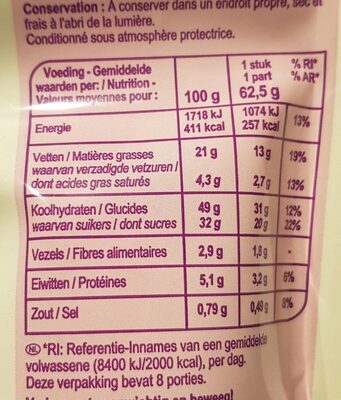Moelleux au Chocolat avec pépites - Carrefour - 500 g
Nota important: aquest producte ja no es ven. Les dades es conserven només com a referència. Aquest producte no apareix a les cerques habituals i no es té en compte per a les estadístiques.
Aquesta pàgina del producte no està completa. Podeu ajudar a completar-la editant-la i afegint-hi més dades a partir de les fotos ja disponibles, o fent-ne més amb l'aplicació de androide o iPhone / iPad. Gràcies!
×
Algunes de les dades d’aquest producte les ha proporcionat directament el fabricant Carrefour.
Codi de barres: 5400101064300 (EAN / EAN-13)
Nom comú: Pâte à gâteau prête à cuire pour moelleux au chocolat avec pépites.
Quantitat: 500 g
Marques: Carrefour
Categories: fr:Cake au chocolat
Botigues: Carrefour
Matching with your preferences
Entorn
Empaquetament
Transport
Altres dades
Preparació: 8 parts |Rien à ajouter | Cuisson : 20-30 min Ustensile nécessaire : un moule rond antiadhésif de 24 cm à bord haut. 1 Préchauffez votre four 10-15 minutes à 150°c - thermostat 5. 2 Versez le contenu du sachet dans un moule rond antiadhésif de 24 cm à bord haut, préalablement beurré. Pressez bien le sachet et roulez-le depuis le bas jusqu'en haut pour le vider entièrement. 3 Mettez à cuire au four pendant 20 à 30 minutes. Au bout de 20 minutes, vérifiez la cuisson en plantant la lame d'un couteau au milieu du gâteau. Si elle ressort propre, votre gâteau est cuit, dans le cas contraire, prolongez la cuisson en renouvelant l'opération régulièrement. 4 Sortez le gâteau du four et attendez au moins 15 minutes avant de le démouler. L'astuce gourmande Servez avec un glaçage à la framboise. Faites chauffer de la confiture à feu doux et quand elle est bien liquide, versez-la sur le gâteau.
Condicions de conservació: Conditionné sous atmosphère protectrice. À conserver dans un endroit sec et frais, à l'abri de la lumière. Après préparation, à conserver au réfrigérateur et à consommer dans les 24h. Pour une dégustation optimale, à consommer de préférence avant le : voir au dos du sachet.
Servei al client: Interdis - TSA 91431 - 91343 MASSY Cedex - France.
Report a problem
Fonts de dades
Producte afegit per kiliweb
Última modificació de la pàgina del producte per org-carrefour.
La pàgina del producte, també editada per openfoodfacts-contributors, roboto-app, teolemon, yuka.ZTQ4ZU1mc1krS1Jhb2RveTBFdnUyTzVNM1orNEFVUHZPOG9QSWc9PQ.








